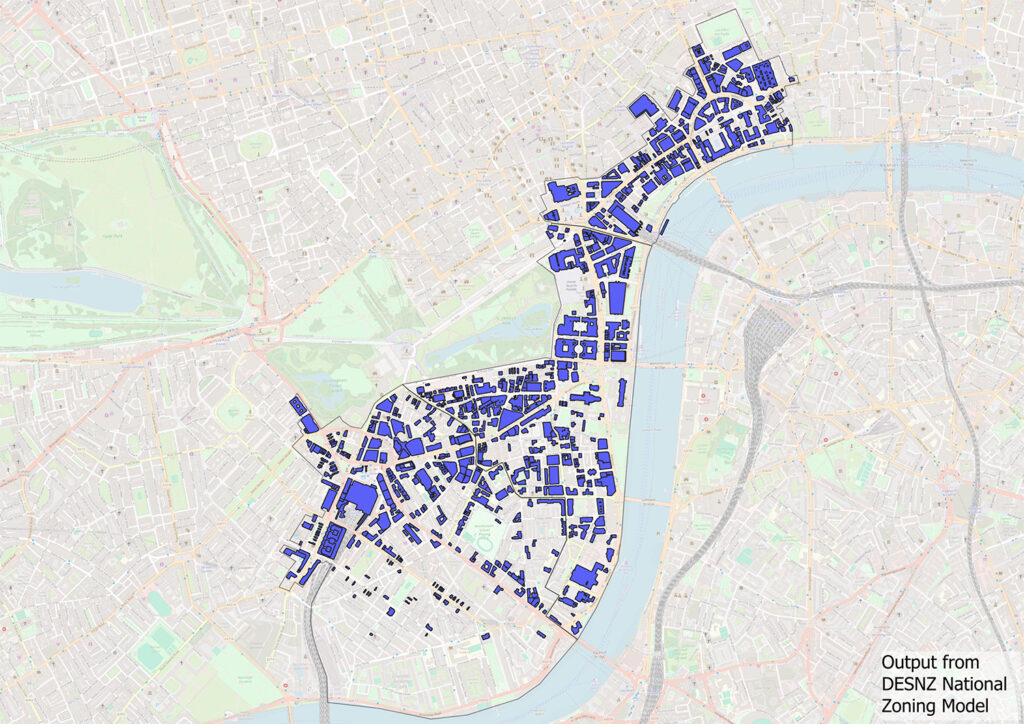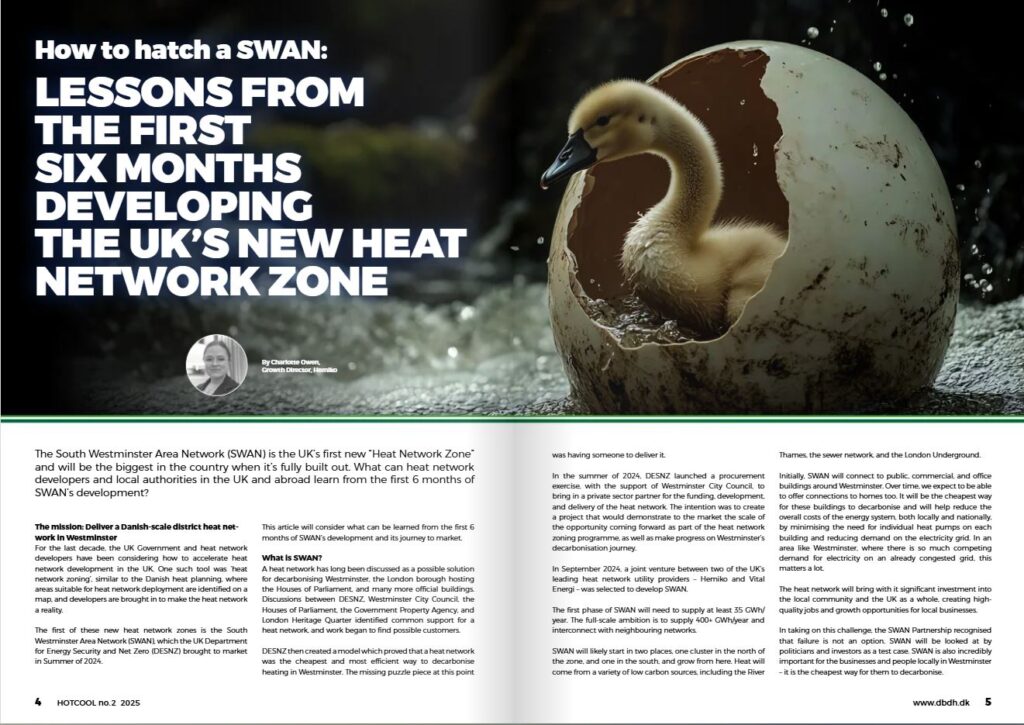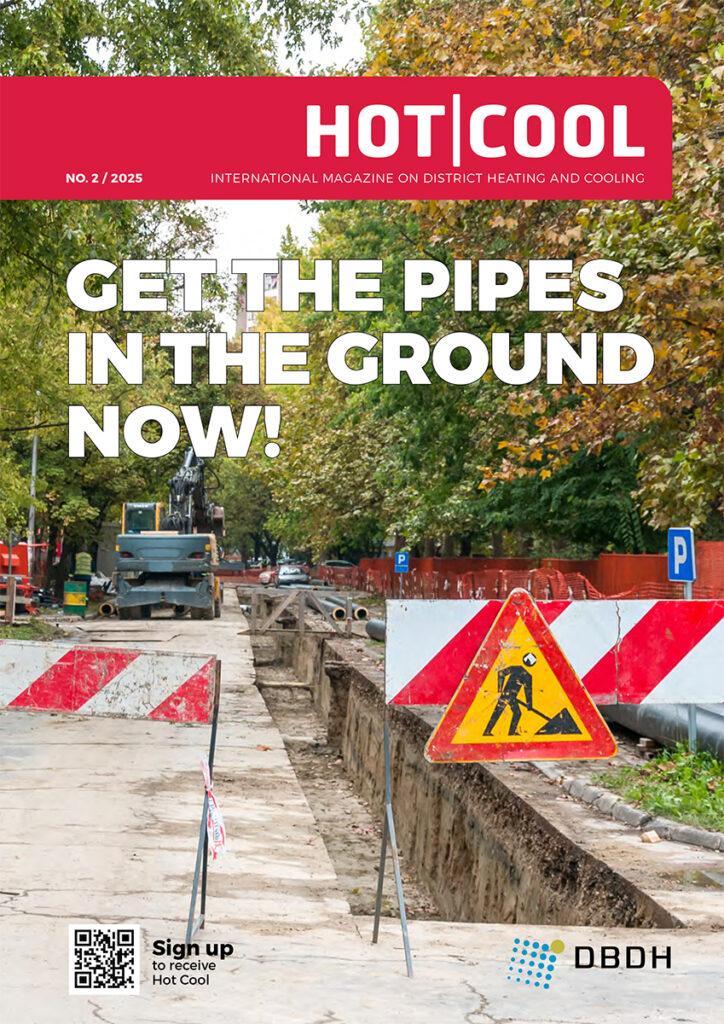The South Westminster Area Network (SWAN) is the UK’s first new “Heat Network Zone” and will be the biggest in the country when it’s fully built out. What can heat network developers and local authorities in the UK and abroad learn from the first 6 months of SWAN’s development?
By Charlotte Owen, Growth Director, Hemiko
Published in Hot Cool, edition no. 2/2025 | ISSN 0904 9681 |
The mission: Deliver a Danish-scale district heat network in Westminster
For the last decade, the UK Government and heat network developers have been considering how to accelerate heat network development in the UK. One such tool was ‘heat network zoning’, similar to the Danish heat planning, where areas suitable for heat network deployment are identified on a map, and developers are brought in to make the heat network a reality.
The first of these new heat network zones is the South Westminster Area Network (SWAN), which the UK Department for Energy Security and Net Zero (DESNZ) brought to market in the summer of 2024.
This article will consider what can be learned from the first 6 months of SWAN’s development and its journey to market.
What is SWAN?
A heat network has long been discussed as a possible solution for decarbonising Westminster, the London borough hosting the houses of Parliament and many more official buildings. Discussions between DESNZ, Westminster City Council, the Houses of Parliament, the Government Property Agency, and London Heritage Quarter identified common support for a heat network, and work began to find possible customers.
DESNZ then created a model which proved that a heat network was the cheapest and most efficient way to decarbonise heating in Westminster. The missing puzzle piece at this point was having someone to deliver it.
In the summer of 2024, DESNZ launched a procurement exercise, with the support of Westminster City Council, to bring in a private sector partner for the funding, development, and delivery of the heat network. The intention was to create a project that would demonstrate to the market the scale of the opportunity coming forward as part of the heat network zoning programme, as well as make progress on Westminster’s decarbonisation journey.
In September 2024, a joint venture between two of the UK’s leading heat network utility providers – Hemiko and Vital Energi – was selected to develop SWAN.
The first phase of SWAN will need to supply at least 35 GWh/year. The full-scale ambition is to supply 400+ GWh/year and interconnect with neighbouring networks.
SWAN will likely start in two places, one cluster in the north of the zone, and one in the south, and grow from here. Heat will come from a variety of low carbon sources, including the River Thames, the sewer network, and the London Underground.
Initially, SWAN will connect to public, commercial, and office buildings around Westminster. Over time, we expect to be able to offer connections to homes too. It will be the cheapest way for these buildings to decarbonise and will help reduce the overall costs of the energy system, both locally and nationally, by minimising the need for individual heat pumps on each building and reducing demand on the electricity grid. In an area like Westminster, where there is so much competing demand for electricity on an already congested grid, this matters a lot.
The heat network will bring with it significant investment into the local community and the UK as a whole, creating high-quality jobs and growth opportunities for local businesses.
In taking on this challenge, the SWAN Partnership recognised that failure is not an option. SWAN will be looked at by politicians and investors as a test case. SWAN is also incredibly important for the businesses and people locally in Westminster – it is the cheapest way for them to decarbonise. We need to catalyse the network now so that the green infrastructure is ready for them when they need it.
Lesson 1: All heat networks start somewhere; don’t get overwhelmed
When SWAN launched to the market, it was a major milestone in the UK heat networks industry. The scale of ambition had just formally jumped up about 100 notches.
But to some heat network developers SWAN looked risky. Depending on your stance, the scale of the project and the attention of some of the UK’s most influential people was either really exciting or completely daunting. It’s safe to say this split opinion amidst UK heat network developers.
What those people did not recognise is that SWAN, like all heat networks, has to start somewhere. And that makes it not all that different from any other heat network.
One of the core benefits of the SWAN model is that the SWAN Partnership has been allowed to decide where to start the network and what the shape of that first phase looks like. This matters because the SWAN Partnership can start the heat network in the place with the best chance of getting it off the ground. It, therefore, has a high chance of success.
Lesson 2: Select a development partner quickly
From start to finish, the procurement exercise for SWAN took just 4 months. This is down from an industry average of somewhere around 18 months. This showed the potential for speeding things up in the market and getting more heat networks in development faster. This speedy procurement timeline means that Westminster will decarbonise faster.
Lesson 3: Find the customers with a reason to decarbonise, and talk to the right people
One of the biggest challenges for the UK heat networks market is that we are trying to sell businesses something similar to their boiler but for more money. They are more expensive because new heat networks in the UK must be low carbon, running mostly on electricity. In the UK, electricity is significantly more expensive than natural gas, in large part because of taxes and levies sitting on electricity rather than natural gas. Unless organisations really care about decarbonisation, that’s a hard sell.
The best place to start a heat network is therefore in a place where there is a concentration of big brands that have made sustainability commitments, or public sector organisations that have access to grant funding. Sounds like Westminster, right?
SWAN has been able to take a running start and get going quickly on customer engagement because DESNZ and Westminster City Council worked so closely with local business representatives, London Heritage Quarter, to engage businesses early and get them thinking about the heat network.
Our job is now to figure out how to encourage these organisations to make the decision to decarbonise. We need all the tools in our arsenal to achieve this. This means getting organisations to think about the ‘whole package’ and not just the costs.
We encourage our customers to think about the community benefit they create when they join heat networks, the reduced hassle, the added resilience, and the ‘all included’ costs. The message that heat networks are compatible with heritage buildings and reduce the architectural impact compared to a building-level heat pump has also been well received.
Anyone developing a heat network also needs to make sure that they are talking to the right people in an organisation early. The right people are financial decision-makers, as well as technical experts.
Fortunately, Westminster has a high concentration of businesses and organisations that have put sustainability at the heart of what they do, with motivated and engaged CEOs and CFOs. Many have set net zero targets or have strong ESG commitments. Some also have access to grant funding from government to help.
Lesson 4: Be ready and willing to change plans
Because customers change their mind, heat network developers need to be ready to change their plans. Technical teams and sales teams need to work in synchronisation, so that if one customer drops off the planned network, a new one can be brought in. This might mean moving potential pipe routes or even energy centre locations. Having a rigid idea of what the first phase of the heat network looks like will not work.
Lesson 5: Remember the heat network developers are a long-term utility partner – focus on setting up a good relationship with the community
The difference between a successful heat network zone and an unsuccessful one will be how well the heat network developer integrates with the local community.
Heat network zone developers are doing something fundamentally disruptive. They must build goodwill and trust amongst the community. Disruption must not be the first thing that people think about when they think about the heat network. And developers must absolutely remember that not everyone cares about decarbonisation, and that doing good for the planet is not enough to sway local opinion.
The SWAN Partnership is therefore putting communicative construction and social value delivery at the heart of what we do.
How we are doing this will change over time. Right now, in these early stages, the core focus is on keeping the community engaged, informed, and consulted. We are working with London Heritage Quarter to do to this via events, newsletters, 1-2-1 engagement, and working groups.
As the network progresses, we will bring together a wider pool of community representatives to hear our updates, have their say on the project, and shape the SWAN Partnership’s social value offering.
Soon, we will be ramping up our delivery of local social value and community benefits, which will peak during construction. This will range from delivering local jobs employed directly by the SWAN Partnership, opportunities for the local supply chain, and curriculum support and skills growth in the local area, as well as local grants and funding.
How to hatch a SWAN
SWAN is not just a technical endeavour, but a blueprint for what can be achieved when heat network developers are brought in early, working to deliver goals shared with a local authority. The partnership between Hemiko and Vital Energi, supported by key stakeholders like Westminster City Council, DESNZ, and London Heritage Quarter, underscores the importance of unified efforts in delivering green infrastructure and tackling climate change.
Ultimately, SWAN’s legacy will be measured by its impact on the local community and its role in setting a precedent for future heat networks across the UK. SWAN can prove that with the right vision and collaboration, our net zero future is within reach.
For further information please contact: SWAN@hemiko.com
“How to hatch a SWAN: Lessons from the first six months developing the UK’s new heat network zone” was published in Hot Cool, edition no. 2/2025. You can download the article here:
Did you find this article useful?
Subscribe to the HOT|COOL newsletters for free and get insightful articles on a variety of topics delivered to your inbox twice a month!



